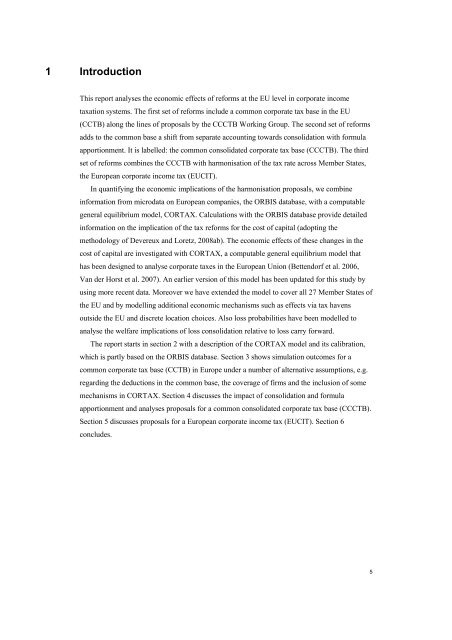The economic effects of EU-reforms in corporate income tax systems
The economic effects of EU-reforms in corporate income tax systems
The economic effects of EU-reforms in corporate income tax systems
Create successful ePaper yourself
Turn your PDF publications into a flip-book with our unique Google optimized e-Paper software.
1 Introduction<br />
This report analyses the <strong>economic</strong> <strong>effects</strong> <strong>of</strong> <strong>reforms</strong> at the <strong>EU</strong> level <strong>in</strong> <strong>corporate</strong> <strong>in</strong>come<br />
<strong>tax</strong>ation <strong>systems</strong>. <strong>The</strong> first set <strong>of</strong> <strong>reforms</strong> <strong>in</strong>clude a common <strong>corporate</strong> <strong>tax</strong> base <strong>in</strong> the <strong>EU</strong><br />
(CCTB) along the l<strong>in</strong>es <strong>of</strong> proposals by the CCCTB Work<strong>in</strong>g Group. <strong>The</strong> second set <strong>of</strong> <strong>reforms</strong><br />
adds to the common base a shift from separate account<strong>in</strong>g towards consolidation with formula<br />
apportionment. It is labelled: the common consolidated <strong>corporate</strong> <strong>tax</strong> base (CCCTB). <strong>The</strong> third<br />
set <strong>of</strong> <strong>reforms</strong> comb<strong>in</strong>es the CCCTB with harmonisation <strong>of</strong> the <strong>tax</strong> rate across Member States,<br />
the European <strong>corporate</strong> <strong>in</strong>come <strong>tax</strong> (<strong>EU</strong>CIT).<br />
In quantify<strong>in</strong>g the <strong>economic</strong> implications <strong>of</strong> the harmonisation proposals, we comb<strong>in</strong>e<br />
<strong>in</strong>formation from microdata on European companies, the ORBIS database, with a computable<br />
general equilibrium model, CORTAX. Calculations with the ORBIS database provide detailed<br />
<strong>in</strong>formation on the implication <strong>of</strong> the <strong>tax</strong> <strong>reforms</strong> for the cost <strong>of</strong> capital (adopt<strong>in</strong>g the<br />
methodology <strong>of</strong> Devereux and Loretz, 2008ab). <strong>The</strong> <strong>economic</strong> <strong>effects</strong> <strong>of</strong> these changes <strong>in</strong> the<br />
cost <strong>of</strong> capital are <strong>in</strong>vestigated with CORTAX, a computable general equilibrium model that<br />
has been designed to analyse <strong>corporate</strong> <strong>tax</strong>es <strong>in</strong> the European Union (Bettendorf et al. 2006,<br />
Van der Horst et al. 2007). An earlier version <strong>of</strong> this model has been updated for this study by<br />
us<strong>in</strong>g more recent data. Moreover we have extended the model to cover all 27 Member States <strong>of</strong><br />
the <strong>EU</strong> and by modell<strong>in</strong>g additional <strong>economic</strong> mechanisms such as <strong>effects</strong> via <strong>tax</strong> havens<br />
outside the <strong>EU</strong> and discrete location choices. Also loss probabilities have been modelled to<br />
analyse the welfare implications <strong>of</strong> loss consolidation relative to loss carry forward.<br />
<strong>The</strong> report starts <strong>in</strong> section 2 with a description <strong>of</strong> the CORTAX model and its calibration,<br />
which is partly based on the ORBIS database. Section 3 shows simulation outcomes for a<br />
common <strong>corporate</strong> <strong>tax</strong> base (CCTB) <strong>in</strong> Europe under a number <strong>of</strong> alternative assumptions, e.g.<br />
regard<strong>in</strong>g the deductions <strong>in</strong> the common base, the coverage <strong>of</strong> firms and the <strong>in</strong>clusion <strong>of</strong> some<br />
mechanisms <strong>in</strong> CORTAX. Section 4 discusses the impact <strong>of</strong> consolidation and formula<br />
apportionment and analyses proposals for a common consolidated <strong>corporate</strong> <strong>tax</strong> base (CCCTB).<br />
Section 5 discusses proposals for a European <strong>corporate</strong> <strong>in</strong>come <strong>tax</strong> (<strong>EU</strong>CIT). Section 6<br />
concludes.<br />
5
















